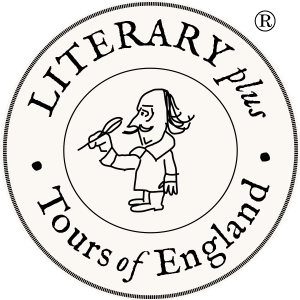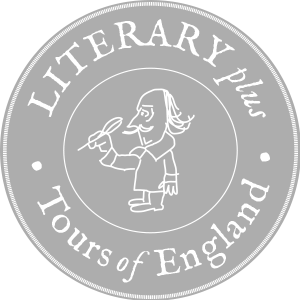02 Nov Jane Austen’s Bath (and Beyond)
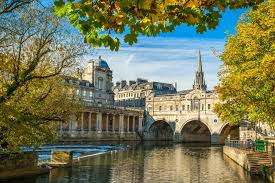

“The person … who has not pleasure in a good novel must be intolerably stupid.” – Jane Austen
Bath is a special place and an essential stop on any tour of England, literary or otherwise. It was built by the Romans around the only natural hot springs in England and it’s been preserved for its marvelous Roman remains and its Georgian architecture in the Palladian style. No wonder the entire city has been designated a World Heritage Site.
Jane Austen and Bath
Jane Austen lived in Bath – unhappily – from 1801 to 1806 and the city, especially its social life, provided inspiration for her novels. Persuasion and Northanger Abbey were even set there. Judy and I visited Bath during our literary tour of England. We especially enjoyed the Jane Austen Centre, a modest museum commemorating Jane’s time in the city. On the front steps we were greeted by Mr Bennet from Pride and Prejudice. Actually it was Martin Salter, who’s said to be the most photographed man in England! The museum features an instructive video presentation and costumed guides. There’s also a fine gift shop and Regency Tea Room.

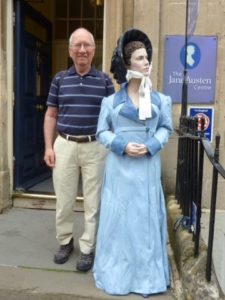
If you’re in Bath in mid-September you’ll be able to enjoy the annual Jane Austen Festival: ten days of literary-inspired events. The Grand Regency Costumed Promenade, which begins the festival, is fun to watch (even more so to take part). As you might expect, Bath has been used as a location for many feature films and TV shows, including the BBC’s excellent 2007 adaptation of Persuasion, starring Sally Hawkins.
Exploring Historic Bath
Judy and I also enjoyed many of Bath’s other attractions. The Roman Baths are spectacular. It was an amazing experience to wander through these magnificent ruins and marvel at how they have been so brilliantly preserved. The experience was enhanced by the many interactive displays illustrating how Bath’s natural hot springs have been attracting visitors for thousands of years. Nowhere else in the Roman Empire has such a large collection of baths, treatment rooms and shrines been discovered. Hot mineral water pours forth at a reliable 13 liters per second. And excavations suggest there was human activity around the spring as long ago as 8,000 years. This all came to vivid life for Judy and me as we listened, through the freely available audio guides, to the informative and entertaining commentary by the inimitable Bill Bryson.
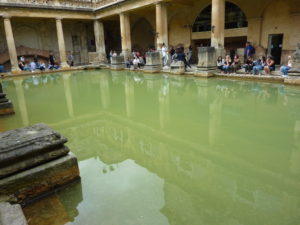
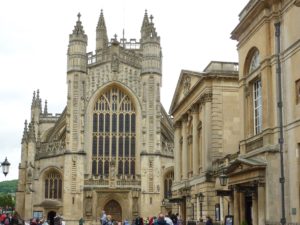
From the entrance to the Roman Baths, in the Abbey Churchyard, there’s a marvelous view of the west front of Bath Abbey. From here begins a free audio walking tour, In the Footsteps of Jane Austen, that includes many of the city’s principal sites. Be sure to linger at No. 1 Royal Crescent (now a museum), The Circus (a unique blend of classical Roman and British pagan influences) and Pulteney Bridge, built in 1773 and lined with shops. Speaking of which, Bath offers some of the best shopping outside London.
Lacock Abbey and Village
A 30-minute drive east from Bath brought us to the preserved village of Lacock and its Abbey, instantly recognizable as a location for countless period dramas in film and television, notably the memorable BBC television adaptation of Pride and Prejudice (1995) starring Colin Firth and Jennifer Ehle. Others include Cranford (2007), The Other Boleyn Girl (2008), Henry V (2012), several Harry Potter films (2001-11) and, most recently, Downton Abbey (2019). Lacock Abbey is actually a rather quirky country house, owned by the National Trust, now housing a museum dedicated to William Henry Fox Talbot, its former resident, the father of British photography.
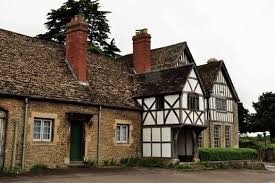
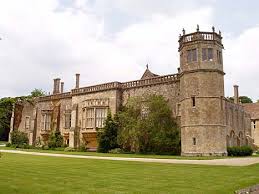
Jane Austen’s Hampshire
One hundred miles southeast of Lacock is King Alfred the Great’s 9th Century capital, Winchester, a charming city criss-crossed by ancient streets and dominated by one of the largest Gothic cathedrals in Europe. Jane Austen is buried there, as also is Izaak Walton, author of The Compleat Angler (1653).
Austen was born in 1775 in the nearby village of Steventon, where her father was the parish rector, and she spent much of her early life there. Following numerous moves around southern England, notably Bath (1801-06), the family returned to Hampshire. In 1809 they settled in Chawton, described by Jane as “a remarkably pretty village”. Their home is now the Jane Austen’s House Museum – one of the most delightful and popular literary sites in England – and it’s there that Jane spent the last eight years of her short life.
Visitors quickly become immersed in Jane’s world, especially when they imagine her sitting at the little three-legged walnut table she used as a writing desk. Not many other authentic pieces have survived, but numerous family portraits and possessions have been arranged to illustrate the life of the Austen family. The most poignant artifact is possibly the donkey cart displayed in one of the outbuildings, which was used by Jane when she had become too ill to walk.
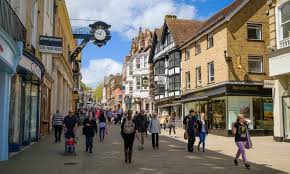
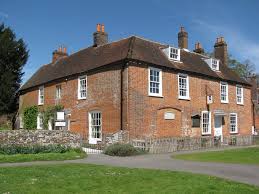
Austen was much happier in rural Chawton than she had been in the big city of Bath. That’s probably why these final years were an especially productive time. She edited Sense and Sensibility (1811) and Pride and Prejudice (1813) prior to their publication. Then she wrote Mansfield Park (1814), Emma (1816) and Persuasion (1818). She even started another novel, Sanditon, but managed to complete only eleven chapters. The unfinished work, published in 1925, was rather controversially ‘completed’ and adapted by Andrew Davies for BBC television.
Jane Austen was a shrewd observer of human nature. Her writing is characterized by realism and her use of humor and irony, which explains its enduring freshness. She has been credited with pioneering the modern novel and her work has influenced many generations of novelists that have followed. Countless film and television adaptations are testimony to her continued relevance and popularity.
In early 1816 Austen started to feel unwell. The nature of her illness is a matter of conjecture, but her condition gradually deteriorated. She was taken to Winchester for treatment in May 1817 and died there in July. She is commemorated by a life-size bronze statue in the Market Place of Basingstoke, the nearest large town to Chawton. Another life-size bronze statue is planned for Bath. There is a memorial tablet in Poets’ Corner in Westminster Abbey in London.
If you’re thinking of visiting Bath, allow at least one day (preferably two or three) to explore the city (including the Jane Austen Centre). Be sure to outfit yourself with comfortable shoes, a light jacket and a keen sense of history. Looking for more to do in the area? Consider Avebury which, together with Stonehenge and other prehistoric monuments in the area, forms a unique World Heritage Site. To visit Bath, Winchester, Avebury and other fascinating sites associated with your favorite writers, plan your itinerary here.
